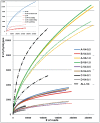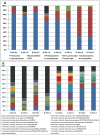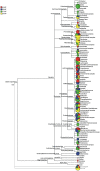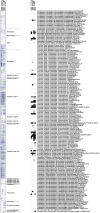Comparative analysis of pyrosequencing and a phylogenetic microarray for exploring microbial community structures in the human distal intestine
- PMID: 19693277
- PMCID: PMC2725325
- DOI: 10.1371/journal.pone.0006669
Comparative analysis of pyrosequencing and a phylogenetic microarray for exploring microbial community structures in the human distal intestine
Abstract
Background: Variations in the composition of the human intestinal microbiota are linked to diverse health conditions. High-throughput molecular technologies have recently elucidated microbial community structure at much higher resolution than was previously possible. Here we compare two such methods, pyrosequencing and a phylogenetic array, and evaluate classifications based on two variable 16S rRNA gene regions.
Methods and findings: Over 1.75 million amplicon sequences were generated from the V4 and V6 regions of 16S rRNA genes in bacterial DNA extracted from four fecal samples of elderly individuals. The phylotype richness, for individual samples, was 1,400-1,800 for V4 reads and 12,500 for V6 reads, and 5,200 unique phylotypes when combining V4 reads from all samples. The RDP-classifier was more efficient for the V4 than for the far less conserved and shorter V6 region, but differences in community structure also affected efficiency. Even when analyzing only 20% of the reads, the majority of the microbial diversity was captured in two samples tested. DNA from the four samples was hybridized against the Human Intestinal Tract (HIT) Chip, a phylogenetic microarray for community profiling. Comparison of clustering of genus counts from pyrosequencing and HITChip data revealed highly similar profiles. Furthermore, correlations of sequence abundance and hybridization signal intensities were very high for lower-order ranks, but lower at family-level, which was probably due to ambiguous taxonomic groupings.
Conclusions: The RDP-classifier consistently assigned most V4 sequences from human intestinal samples down to genus-level with good accuracy and speed. This is the deepest sequencing of single gastrointestinal samples reported to date, but microbial richness levels have still not leveled out. A majority of these diversities can also be captured with five times lower sampling-depth. HITChip hybridizations and resulting community profiles correlate well with pyrosequencing-based compositions, especially for lower-order ranks, indicating high robustness of both approaches. However, incompatible grouping schemes make exact comparison difficult.
Conflict of interest statement
Figures








References
Publication types
MeSH terms
Substances
LinkOut - more resources
Full Text Sources
Other Literature Sources
Research Materials

